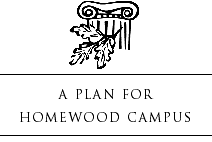|
|
Start of 'Great Excavations' at HomewoodBy Dennis O'SheaHomewood |

Tons of bricks are about to hit the Homewood campus like -- well, like a ton of bricks.
Flatbed trucks have begun rolling onto campus with the first of 1 million or more bricks to be delivered over the next few months. The pavers will be laid down this summer, replacing acres of asphalt walks and roads in perhaps the most dramatic remaking of Homewood since Johns Hopkins first occupied the ridge above Charles Street 86 years ago.
It's a whole lot of bricks.
The initial order of 900,000 will arrive on 139 trucks, one to two trucks per day, said Steve Campbell, interim executive director of Facilities Management. Each truck carries 12 pallets, with 540 bricks per pallet.
A staging area has been set up south of the AMRs and just north of Homewood House Museum. After Spring Fair, a second area will open in the southern end of the lower quad. The bricks will be stored in those two spots until the project gets under way, immediately after commencement.
 The massive summer project all along the central spine of
campus, from University Parkway to Shriver Hall, represents an
unexpectedly early implementation of key aspects of the new
Homewood master plan. Though a few
issues remain unresolved and the overall plan is not quite final,
there is broad agreement on the goal of creating a quieter, more
wooded, more contemplative campus core without daily games of
"chicken" among pedestrians, cars and massive delivery trucks.
The massive summer project all along the central spine of
campus, from University Parkway to Shriver Hall, represents an
unexpectedly early implementation of key aspects of the new
Homewood master plan. Though a few
issues remain unresolved and the overall plan is not quite final,
there is broad agreement on the goal of creating a quieter, more
wooded, more contemplative campus core without daily games of
"chicken" among pedestrians, cars and massive delivery trucks.
That agreement and the strong interest of an anonymous donor have led to a project--actually, more of a three-month blitz--that will include not only installation of brick paths and diversion of most traffic away from the center of campus but also massive relandscaping, particularly in the upper and lower quads and near the AMRs. The project also includes new signage, improved handicapped access, information kiosks at the entrances to campus, attractive and consistent lighting and redesigned shipping and receiving systems.
All this--along with simultaneous construction of the student arts center, Clark Hall and the new recreation center on the eastern, western and northern edges of campus--will result in a huge long-term gain for Homewood, university officials say. But it will come at the expense of short-term pain for those who will be on campus this summer to endure the noise, dust and detours caused by construction.
The university--with a nod to Dickens fans in the English Department--is dubbing the summer work "Great Excavations" and planning ways to ease the pain and keep students, faculty and staff in the loop on construction-related news [see box below].
The project's three-month schedule is hugely ambitious; except for some planting that will be postponed until the fall or next spring, all work must be done before students return on Labor Day weekend. In some ways, however, this week's brick delivery represents a leap over the tallest hurdle faced by construction planners. A strong economy has touched off a building frenzy in much of the country, and bricks are scarce. Late last month, a Baltimore business newspaper ran a headline saying, "Brick shortage slows down building boom."
"The shortage is more severe in 'face brick,' used vertically in walls, than in brick pavers, used horizontally in walks," Campbell said. "And by ordering such a large quantity in advance, we reserved the available production capability of the plant for four months."
| GO TO APRIL 3, 2000 TABLE OF CONTENTS. |
| GO TO THE GAZETTE HOMEPAGE. |